
ORP Orkan, formerly HMS Myrmidon, was an M-class destroyer of the Polish Navy during World War II. Orkan is Polish for "hurricane".

BAPFerré(DM-74) was a Daring-class destroyer in service with the Peruvian Navy from 1973 to 2007. She was built by Yarrow Shipbuilders and completed for the Royal Navy in 1953 as HMS Decoy (D106).

HMS Raider was a R-class destroyer built for the Royal Navy during the Second World War.

HMS Penn was a P-class destroyer built for the Royal Navy during the Second World War.

HMS Carnarvon Bay was a Bay-class anti-aircraft frigate built for the Royal Navy during World War 2.

HMS Wrangler was one of eight W-class destroyers built for the Royal Navy during World War II. Completed in 1944, the ship spent most of the war in the Far East and escorted British aircraft carriers as their aircraft attacked targets in the occupied Dutch East Indies and in Japan itself. Wrangler was present in Tokyo Bay when the Japanese formally surrendered on 2 September 1945.

HMS Terpsichore was a T-class destroyer built for the Royal Navy during the Second World War.
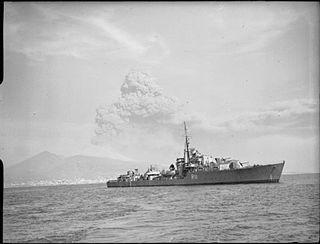
HMS Tumult was a T-class destroyer built for the Royal Navy during the Second World War.

HMS Scourge was an S-class destroyer built for the Royal Navy during the Second World War. The ship was sold to the Netherlands postwar, where it saw action in the Korean War and the West New Guinea dispute.

HMS Racehorse was a R-class destroyer built for the Royal Navy during the Second World War.

HMS Redoubt was an R-class destroyer built for the Royal Navy during the Second World War.
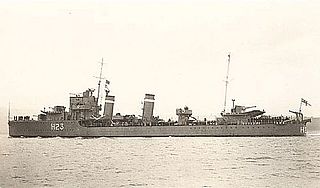
HMS Echo was an E-class destroyer of the British Royal Navy that saw service in the Atlantic, Arctic and Mediterranean theatres during World War II, before being transferred to the Royal Hellenic Navy in 1944, and renamed Navarinon, until scrapped in 1956.
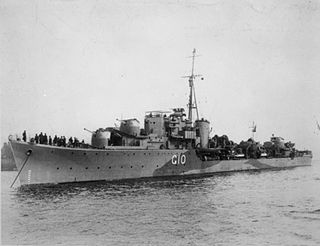
HMS Pathfinder was a P-class destroyer built for the Royal Navy during the Second World War. She was damaged while serving in the Far East, and was scrapped after the end of the war.

HMS Chiddingfold (L31) was a Type II Hunt-class destroyer of the Royal Navy. She was leased to the Indian Navy in 1952 where she served as INS Ganga (D94).
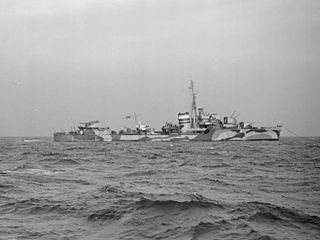
HMS Loyal was a L-class destroyer built for the Royal Navy in the late 1930s, although she was not completed until after World War II had begun.
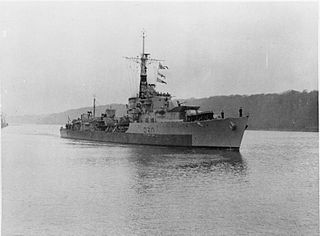
HMS Carron was one of thirty-two C-class destroyers built for the Royal Navy during the Second World War, a member of the eight-ship Ca sub-class. Commissioned in late 1944, she was assigned to the Home Fleet and escorted the fleet's larger ships during operations off German-occupied Norway. Carron was sold for scrap in 1967.

HMS Cavendish was one of eight C-class destroyers built for the Royal Navy during the Second World War. Commissioned in late 1944, she was built as a flotilla leader with additional accommodation for staff officers. The ship was assigned to the Home Fleet in 1945 after working up where she escorted capital ships of the fleet. Cavendish was sold for scrap in 1967.

HMS Caesar was one of thirty-two C-class destroyers built for the Royal Navy during the Second World War, a member of the eight-ship Ca sub-class. Commissioned in 1944, she was built as a flotilla leader with additional accommodation for staff officers. The ship was assigned to Home Fleet during 1944–1945 and escorted one Arctic convoy as well as the capital ships of the fleet.

HMS Childers was one of thirty-two C-class destroyers built for the Royal Navy during the Second World War, a member of the eight-ship Ch sub-class. Commissioned in 1945, she was built as a flotilla leader with additional accommodation for staff officers.

HMS Comet was one of thirty-two C-class destroyers built for the Royal Navy during the Second World War, a member of the eight-ship Co sub-class.




















